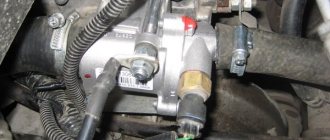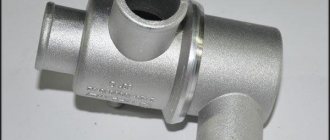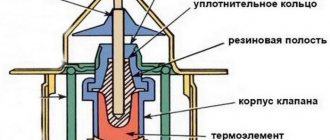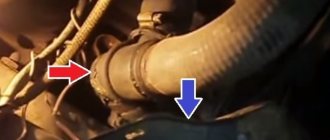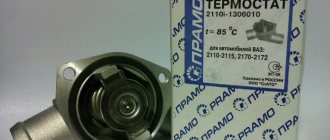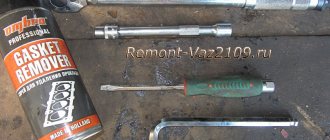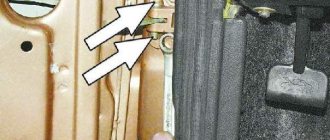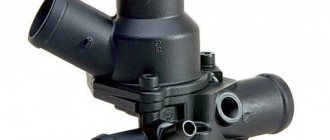Hi all!
Today we will talk about the most common causes of chisel motor overheating.
I will talk about my experience in repairing and operating a car, so there will be no stupid copying of text in this post. Please do not judge strictly, because... I'm not a professional auto mechanic! The main causes of overheating:
1) The most common reason is a non-working coolant fan
.
I think everyone is familiar with the principle of operation of the coolant fan - it forcibly cools the engine. It may not work for several reasons: 1.1 The coolant temperature sensor is not working. 1.2 No power to the coolant sensor 1.3 The coolant fan itself does not work
CHECKING THE TEMPERATURE SENSOR
So, if you see that the cause of engine overheating is the coolant fan not turning on, the first thing you need to do is check whether it is receiving power.
Now turn on the ignition! For carburetor
models 2109, the coolant sensor is located on the radiator.
There are 2 wires coming to it and in order to check if there is power on them, simply short them. Don't be alarmed, it's the fan that turned on :)! If it does not turn on, then see the following points. On the injector,
the sensor is located next to the thermostat, under the air filter.
It also comes with 2 wires, but here, unlike the carburetor, you don’t need to short-circuit the wires with each other, you just need to pull out the block and the coolant fan will turn on. If after these steps the fan does not turn on, there are two reasons: No power; There is power, but the fan does not work. To finally make sure there is power, you need to ring the contacts with a multimeter or test lamp. If there is no power, then first of all we look at the fuse, and since the +
of the coolant sensor sits on the same fuse with the signal, it’s enough to just press the horn, but even the horn may not work
IT’S THE SAME FUCKING VAZ :):)
Just look at the fuse if it is intact, we follow the diagram and look at all the contacts.
If there is power, then we simply connect the fan directly to the plus
and
minus
of the battery - now it should turn on, didn’t it turn on? This means we need to replace the fan, or try to repair it :)
2) The second reason is the absence or insufficient circulation of coolant!
2.1 Something with the pump. Anything can happen to it :) To check, start the engine, open the hood, unscrew the cap of the expansion tank and, using the accelerator cable, check the emissions through the return pipe; if there is movement and the antifreeze is bubbling, then most likely everything is fine with the pump.
2.2 Air lock. In SAMARA, it’s usually enough just to stand on a hillock with your muzzle and gas with the lid open.
3) The third reason is the thermostat!
What is a thermostat? Thermostat - a device for maintaining a constant temperature
(excerpt from Wikipedia). As some people may or may not know, the cooling system in a VAZ 2109 car consists of a small and a large circle. Up to 87 degrees, the pump pumps antifreeze in a small circle, bypassing the coolant radiator, after this number the thermostat turns on and the antifreeze moves in a large circle through the radiator. This creates the required operating temperature of the engine. If you overheat the engine (as I did), then there is a chance that the thermostat will jam in one of two positions - either on a small circle or on a small and large circle.
Checking the thermostat:
The checking procedure is quite simple, like everything on a VAZ :) If the engine overheats, you need to warm it up to 90 degrees and open the hood to test the pipes, they should be at approximately the same temperature. For me, the lower radiator hose was cold, and the upper one was hot - the reason the thermostat was stuck on a small circle! If the engine warms up to operating temperature for a very long time (or does not warm up to it at all), then the thermostat is stuck in both coolant circulation circles and it also needs to be changed!
4) The fourth reason is a radiator clogged with dirt.
In order to find out if the radiator is clogged, you need to warm up the engine to operating temperature and touch it in all places :) The temperature should be equally hot, but this was not the case on any of my nines! The bottom of the radiator was always colder than the top, so the main thing is that the engine does not experience a cooling deficit.
We have figured out the reasons, now I will tell you how to change the thermostat. To my surprise, there was a lot of space on the injector under the air filter. The distributor is in the way on the carb, but there is no need to remove it :) First of all, drain the antifreeze, if you do not plan to change it, then drain it into a container. It merges from two holes. The first is located in the lower corner of the radiator (opposite the generator), the second is on the engine just below the spark plug of the 4th cylinder. But here the carburetor already took over, since the same distributor is located directly above the drain hole :) As if AVTOVAZ specifically decided to make fun of the people :) This is what is called the GENIUS of automotive engineering :):) I didn’t bother and didn’t drain the antifreeze from the engine ... Unscrew the clamps holding the thermostat.
How to check the thermostat on VAZ 2115, 2114, 2113, 2109.
Hello. If in winter your car takes a very long time to warm up or the stove does not heat up, or maybe on the contrary, in the summer the car constantly overheats and boils? If you have one of these symptoms, you should check whether the thermostat on your car is working properly. Before checking the thermostat, you need to understand how it works.
The operating principle of the VAZ 2115, 2114, 2113, 2109 thermostat.
What does a thermostat consist of? Let's get a look!
The thermostat consists of a housing, a bypass valve, a main valve, a temperature sensing element (usually located near the main valve) and a spring.
How does the thermostat work on VAZ 2115, 2114, 2113, 2109.
When the car is not warmed up, the thermostat valve is closed, as in the photo. In this case, the coolant moves in a small circle, as in the photo below.
When the machine warms up to operating temperature (87-90 degrees), the temperature-sensitive element slowly begins to heat up, as a result of which the spring compresses, the main valve opens and the liquid flows in a large circle.
How to understand that the thermostat of the VAZ 2115, 2114, 2113, 2109 is faulty?
There are two reasons why you can understand that the thermostat on the VAZ 2115, 2114, 2113, 2109 is faulty:
- The car does not warm up.
- The car overheats and boils.
There are also two ways to check the thermostat:
- Check the removed thermostat for functionality.
- Check the thermostat without removing it from the car.
How is the check carried out?
First of all, it is worth pointing out that on a VAZ-2109 (with an 8-valve engine, as well as a 16-valve engine) you do not need to drain the coolant to check. The procedure is:
- start the engine;
- check the temperature of the lower pipe leaving the radiator.
Normally, it should remain cold, since the liquid circulates only in a small circuit. It heats up gradually. As the coolant reaches a temperature ranging from 87 to 92 degrees and the wax in the thermostat melts, the damper opens and a large circle begins to operate. If this does not happen, then the thermostat will have to be changed.
Before buying a new one, check whether the old one is really damaged. This is not difficult to do, just put the device in a pan of water (on a rag) and heat it to 87-90 degrees. A working device will open the main valve.
Replacing the thermostat Lada 2109 (VAZ 2109)
How to check and replace the VAZ-2109 thermostat (8 or 16 valves)? This procedure is not very complicated, and even a less experienced car owner can handle it without much difficulty. What needs to be done is described in this article.
The thermostat itself is a mechanical device whose operation is based on purely physical principles. Inside it is wax that is sensitive to temperature changes. When the coolant heats up, the substance melts and, as a result, the damper opens, allowing it to enter the cooling system.
Dismantling
If it becomes necessary to remove the thermostat, then it will not be possible to do without draining the coolant. Some craftsmen claim that they were able to avoid the above procedure, but in reality it turns out that this option requires much more labor and still leads to the loss of 3 out of 5 liters of liquid. Therefore, it is better not to suffer and do everything as it should be. To do this, unscrew the plug located at the bottom of the radiator and drain the coolant into a suitable container. Then:
- remove the air filter;
- loosen the clamps holding the hoses;
- disconnect the mass from the thermostat;
- Unscrew the nut and pin holding the device.
Self-replacement of the VAZ-2109 thermostat
How to check and replace the VAZ-2109 thermostat (8 or 16 valves)?
This procedure is not very complicated, and even a less experienced car owner can handle it without much difficulty. What needs to be done is described in this article. The thermostat itself is a mechanical device whose operation is based on purely physical principles. Inside it is wax that is sensitive to temperature changes. When the coolant heats up, the substance melts and, as a result, the damper opens, allowing it to enter the cooling system.
Why is the lower radiator hose cold? List of possible problems and how to fix them
Many motorists ask us why the lower radiator pipe is cold? It is impossible to answer this question in one or more sentences. I had to write a whole article where everything was described in detail. You will find out what is the main reason for this, because with a heated engine this same pipe should not be cold. This situation indicates problems. Why is the lower radiator pipe cold - a question that is asked not only by beginners, but sometimes also by experienced motorists. Let's try to give complete information. Important to know Beginners often make the mistake of believing that the lower pipe should never be cold, they begin to sound the alarm. Advice (especially useful during winter): drive the car into the garage. Let the engine run for 10-20 minutes so that this same pipe has time to heat up, and only then draw your conclusions. The fact is that due to the lack of heat in the cooling system (cold season), the thermostat keeps the large circulation circle closed. If the heater is on, it will prevent the thermostat from opening. Therefore, while the engine is warming up, it must be turned off. If after this the lower pipe is cold, there is a problem. Dirty radiator The main reason for this, according to most experts, is a clogged radiator. Over time, this important element of the cooling system becomes clogged with rust residue, dust, leaves and other debris. The location of the radiator is in front of the car. So, no matter what happens, it gets inside. As a result, all this leads to problems. Since this reason is the most important, below is a method on how to clean a radiator. In addition, proper care of the radiator and its regular prevention ensures the normal operation of the entire cooling system. Once it has been decided to start by flushing the radiator, to eliminate the symptom described above, they proceed in different ways:
- Or they go to the store and buy a new radiator;
- Or you can clean it yourself.
Important points:
- The radiator must be cleaned when the engine has completely cooled down;
- It is recommended to wear protective gloves and firmly fasten the car hood;
- All coolant is drained from the radiator and checked. If the liquid is perfectly clean and there are no traces of rust or scale in it, the radiator is clean and the reason for the cold pipe is different;
- If the liquid is dirty, then that's it. Pour clean water (necessarily distilled) inside. We start the engine and let it run for 20 minutes.
- We drain the water, check for cleanliness and, if necessary, repeat the procedure several times.
Replacing the coolant: Often, when replacing the coolant, newbies make a mistake and then complain about a cold pipe.
This concerns a situation where the radiator itself is freed from old fluid, but the tank is forgotten. As a result, this affects the entire cooling system. It starts to act up and diagnostics give no clue. Thermostat The problem may also be related to the thermostat. This device is small in size and has the ability to block coolant. As a result, problems occur, including those related to the cold pipe. By the way, the problem with the thermostat also affects the upper pipe. It can also be cold, but the bottom one, on the contrary, can be hot. All this taken together cannot in any way indicate the normal operation of the entire cooling system. The thermostat can be replaced with your own hands using a 10 mm socket wrench, a screwdriver and a clean container for liquid. We disconnect the air intake tube, reduce the pressure in the system and unscrew the cap of the expansion tank. We drain the liquid from the thermostat, loosen its bolts and remove the device. As a result, we have given three main reasons why this happens. Thus, having found out why the lower radiator pipe is cold, we draw the appropriate conclusions and act according to the situation. AutoFlit.ru
Checking and replacing the thermostat of a VAZ-2109 car
If the engine overheats while running or is slow to reach operating temperature, you need to check the thermostat.
To check the thermostat on your car, start the engine and touch the lower radiator hose with your hand. It should be cold.
After the coolant temperature reaches 87–92 °C, the hose should begin to heat up. If this does not happen, you need to remove the thermostat and check its functionality.
Unscrew the bolts securing the crankcase protection and remove it.
Unscrew the expansion tank cap.
Place a container under the drain hole, unscrew the cylinder block drain plug and drain the coolant from the cylinder block.
Place a container under the drain hole, unscrew the radiator drain plug and drain the coolant from the radiator
Loosen the clamps
Disconnect the three hoses from the thermostat housing.
Loosen the clamp and remove the thermostat with the hose. Then disconnect the short hose from the thermostat.
Scheme and design
In order to promptly determine the malfunction, check or replace the thermostat, you must first understand its circuit and design elements.
The scheme presented above is deciphered as follows.
| Item number | What is this? |
| 1. | Inlet pipe coming from the radiator |
| 2. | Rubber insert |
| 3. | Heat sensitive solid filler |
| 4. | Bypass valve spring |
| 5. | Inlet pipe coming from the engine |
| 6. | Bypass valve |
| 7. | Outlet pipe going to the pump |
| 8. | Main valve spring |
| 9. | Main valve |
| 10. | Pipe coming from the expansion tank |
| 11. | Piston |
see also
“Peter - AT” INN 780703320484 OGRNIP 313784720500453
What is a VAZ-2109 thermostat, when is it necessary to replace it, what are the main signs of failure, we will tell you in this article. Our publication also contains a detailed description of how to install a more advanced thermostat from a model 2110 car. Its advantages will be discussed a little below. And it’s worth starting with theory; you need to understand what kind of device the thermostat has, what functions it performs in the cooling system of an internal combustion engine.
Symptoms of malfunction
The following indicates that the thermostat is not working properly:
- the long period required for the motor to reach operating temperature;
- rapid overheating of the power plant;
- high coolant temperature.
It is the systemic excess of temperature standards that, as a rule, leads to breakdown of the entire engine. For this reason, it is necessary to replace it at the first sign of a thermostat malfunction.
What is a thermostat?
As the name of the device suggests, it does something with temperature. More specifically, it helps switch fluid flows in the cooling system. Moreover, the thermostat, carburetor or injector are at the heart of the gasoline injection system and have the same composition and housing design. When operating any engine, it is necessary to ensure heating of the throttle assembly. And it is present in any injection system: both in the carburetor and in the injector.
The basis of any thermostat is a special plate, which is made of a material called bimetal. It reacts to temperature changes and is capable of deformation because of this. The switching of air flows is based on this effect: the plate moves the valve, which is fixed by springs. Having overcome their force, the plate moves the valve, opening the path for liquid flow to the main radiator to ensure effective cooling.
The purpose of the thermostat, its location and malfunctions
In modern cars, including the “nine”, the power plant is cooled using liquid (antifreeze, antifreeze). To regulate the temperature of the antifreeze, a thermostat is installed between the radiator and the VAZ 2109 engine. The main functions of this unit are maintaining the desired thermal conditions and warming up the power plant of the VAZ 2109. This is a small cylinder with a valve, which is located under the hood near the cylinder blocks. It is quite easy to find as there are several hoses included in the housing.
Advice! To check whether the device is working or not, you should warm up the VAZ 2109 engine so that the temperature arrow does not reach the limit. After this, you need to turn off the unit, lift the hood and find under it the upper and lower hoses extending from the radiator (about 5 centimeters in diameter, black rubber). You need to carefully touch the hoses; if the lower one is cold and the upper one is hot, then most likely the thermostat is jammed.
There are two main malfunctions: the valve is stuck in a fully or partially open position, the valve is stuck in a fully closed position. In the first case, the engine will take a long time to warm up to normal temperature, and in cold periods the engine may not warm up at all. If the valve does not open completely, then the operating temperature of the power plant will not be higher than 70 degrees. When the valve is stuck in the closed position, the motor can overheat in any operating mode.
Signs of breakdown
What could be the first sign that the VAZ-2109 thermostat is faulty? Of course, the engine overheats even when driving at a high constant speed. The reason is that the liquid continues to circulate in a small circle, not a drop gets into the radiator. And even turning on the electric fan won’t help, because doing so is simply useless. The only thing that can slightly correct the situation is opening the heater tap and turning on the interior airflow at maximum speed.
But such an action will not bring comfort in hot weather. The most common thermostat breakdown is the sensing element jamming in its original position (the liquid moves in a small circle). If this suddenly happens, then you need to try all methods of elimination. Even a few light blows to the body can open the valve. If such an emergency occurs on the road, you will have to drain the liquid and break all the insides of the thermostat so that the liquid circulates only in a large circle. But it won’t boil, and you can get to the repair site.
Preparing for replacement
In order for the car to be completely ready to replace the thermostat, you need to wait until the engine cools down to at least 40-50 degrees. It is extremely dangerous to work while it is hot; you can get burned. The thermostat on a VAZ-2109 is replaced quite quickly; the most difficult and tedious procedure is emptying the system. To do this, you need to use two drain holes, which are located in the lower part of the radiator (the plug is unscrewed by hand) and in the engine block (head bolt 13).
But what should you do if the system is filled with antifreeze, which is quite expensive? We must try to preserve it so that it is not expensive to repair the car. To do this, first of all, by opening the stove tap, unscrew the clamp on the pipe that goes to the throttle valve. It is necessary to drain the maximum possible amount of antifreeze through it. Yes, this procedure is slow, but it will save almost all the liquid. Only after this can you unscrew the plug on the radiator and on the engine block. And don’t forget to unscrew the cap on the expansion tank to increase the pressure.
Diagnosing the thermostat at home
To check the thermostat of a VAZ 2109 car at home, you must first remove the part from the engine. All work must be carried out on a cold car, because... there is a risk of severe burns. Before removing the thermostat, it is necessary to dismantle the crankcase protection and completely drain the antifreeze from the cooling system - after completing the diagnostic work, it can be reused. To drain antifreeze, you must first open the cap of the expansion tank, and then place a previously prepared container for draining the liquid under the cylinder block. Open the drain plug and drain the antifreeze. Then place a container under the radiator drain hole and, unscrewing the plug on it, drain all the coolant.
After draining the antifreeze, you need to loosen the clamps and disconnect several pipes from the thermostat body: the hose from the expansion tank, the outlet hose from the radiator, the hose from the pump pipe, the hose connecting the thermostat to the engine. Having carefully removed the thermostat, the main valve of the part is first subjected to visual diagnostics: it may become stuck in the open position, which causes malfunctions in the operation of the thermostat.
If the valve is closed, then diagnostics of the operation of the VAZ 2109 thermostat is carried out using a slowly heated container of water. The thermostat is immersed in a container together with a thermometer and, gradually heating the water, the moment when the valve begins to operate and the temperature level at this moment is established.
The normal operating temperature of the thermostat of a VAZ 2109 car is considered to be 87 degrees Celsius; an error level of no more than 2-3 degrees is allowed. A properly functioning thermostat will begin to gradually open the valve as the fluid temperature rises, allowing some of the water to flow through the main pipe. When the temperature reaches 108-110 degrees, the thermostat valve should open completely and discharge heated water into the radiator circuit. As it cools, the thermostat removed from the water should completely close the valve.
Replacing the thermostat
Remove the old one, install a new one in its place - this is the entire replacement procedure. But you need to carefully inspect all the pipes of the system. The VAZ-2109 thermostat is connected. The injector or carburetor in the injection system does not matter.
When carrying out work, pay special attention to the clamps. It is highly undesirable to use old ones; it is better to install new ones. Moreover, reliability is an important criterion. Worm-type clamps are very delicate: as soon as you apply a little more force, it breaks. And the possibility of damaging the pipe is very high. If you tighten the clamp too much, you can puncture the rubber. But, of course, you can’t tighten it loosely, as liquid leaks will appear. In other words, this is a double-edged sword. And a little advice: before installation, it is advisable to apply a thin layer of sealant to the surface of the thermostat that will be in contact with the pipe.
What is better than a thermostat with “ten”?
Of course, we are not talking about the models that were included in the first “ten” releases. The VAZ-2109 thermostat (carburetor) is very similar to the one that was installed in the first “ten” models. But now we are talking about more modern models. Their main advantage is that the number of clamps is reduced to a minimum. But the thermostat is not attached to the engine block using a short pipe. The housing is screwed to the engine block using two studs. The temperature sensor is screwed into the thermostat, therefore, the second hole must be plugged.
In addition, when installing the thermostat from “ten” to “nine”, it becomes possible to save a little, because you can only change the sensitive element. Passive benefits include freeing up space under the hood. The thermostat housing becomes five centimeters shorter, which makes it possible to easily reach, for example, the adjusting nuts of the clutch cable.
Installation
In addition to the thermostat, you need to purchase a new pipe through which the coolant can return to the pump. Among motorists it is called a “saxophone”. You can find it by number: 2110-1303055-10. The following tools and materials should also be on hand:
- Clamps 15-28 mm (it is better to take about 7 pieces).
- New gasket.
- Replacement hoses.
- Screwdriver Set.
- Special hose puller (needed for old-style cars).
- Rags.
- Antifreeze.
There are two installation options: standard and alternative. In the first case, the 6-hole thermostat opens for additional cooling. In other words, it monitors the temperature coming out of the engine, not the temperature of the already cooled antifreeze. An alternative option is to check the temperature lower than the motor reading. The installation proceeds according to the following scheme:
- Part of the coolant must be drained; to do this, you need to unscrew the plug from the drain hole;
Along with the drop in temperature due to the gradual arrival of winter, it began to get colder in the car. It began to take more time to warm up the engine, then wait for the coolant temperature to rise to 60 degrees to turn on the heater and warm up. In this regard, I remembered the modification of the cooling system of the VAZ 2109, when instead of the standard thermostat, a 6-hole thermostat from the VAZ 2110 is installed. It is improved in comparison with the standard one and has the following advantages:
— the thermostat has been modified to ensure a more stable coolant temperature; — fewer connections on clamps. The standard thermostat is attached to the outlet pipe through a rubber connecting tube; — the thermostat is made collapsible for the possibility of replacing the thermoelement separately from the body; — the new thermostat is 5 cm shorter than the standard one — there is more space.
To remove the thermostat and not spill antifreeze, you must first release the pipe on the throttle assembly and drain what spills out through it. All you have to do is be careful and not spill antifreeze when disconnecting the return pipe from the heater radiator.
We connect a new thermostat with 6 holes according to the following diagram:
Connecting a 6-hole thermostat according to the standard diagram
It will be necessary to install a new pipe through which the antifreeze is sent back to the pump, the so-called “saxophone” (2110-1303055-10), it is shorter than the standard one from the VAZ-2109. However, newer cars already have this pipe installed from the factory. You may also need hoses, clamps, and a gasket for a new thermostat. It is advisable to try on the thermostat and determine locally whether the hoses will need to be replaced.
Above is a standard connection diagram for a 6-hole thermostat. However, it is recommended to connect such a thermostat using a different, modernized circuit.
Modified thermostat connection diagram for VAZ 2109, VAZ 2108 “injector”
Modified thermostat connection diagram for VAZ 2109, VAZ 2108 “carburetor”
Connecting a 6-hole thermostat
The meaning of this connection is that the coolant, which has given off heat in the heater radiator, is directed back to the temperature-sensitive element of the thermostat (rather than drained into the receiving pipe to the pump), and cools it a little, preventing the large circle from opening until the temperature of the antifreeze coming from the heater won't rise. It turns out that now the thermostat also takes into account the temperature of the coolant from the heater radiator, which makes the engine temperature more stable, and the car will be warmer in winter. To connect you will need a special tee.
Is it possible to install a thermostat 2110 on “nine”?
This question was partly answered in the previous paragraph. Yes, you can install a VAZ-2110 thermostat on a 2109, and it doesn’t matter at all whether the “nine” is carburetor or injection. In fact, starting from the “eight”, the engines are used the same. What can we say, even modern “Grants” are equipped with an engine that has been used on “eights” and “nines” since the 80s. Progress, to say the least. Of course, instead of a carburetor there is now a more modern injection system, which by European standards was outdated 5-10 years ago. And almost all components are interchangeable. There are minor differences and improvements, but this does not change the overall picture.
Refilling the cooling system
It will take you a few minutes to add fluid and bleed the cooling system. First of all, check that all pipes are securely installed and that all clamps are tightened. Then look to see if the engine block and radiator plugs are in place. If not, then install them. Now you can open the stove tap and pour liquid into the expansion tank. The gurgling stopped - they closed the plug and started the engine. Wait until it warms up to operating temperature - about 90 degrees. If necessary, add fluid to the reservoir. It is necessary that its level is between the lower and upper marks.
Question: can a thermostat from 2108 be installed in 2110?
Radiator fan does not turn off on 2110i Yesterday I decided to replace the thermostat due to the radiator fan constantly turning on (the radiator itself was quite cool when the fan was running). Having removed it, I discovered that the thermostat I had was “of the wrong system,” i.e. Externally the same, but internally different. It has a small circle; when the valve of the large circle is opened, it does not close (there is a hole in the valve of the small circle). Those. Of the two paths, the liquid chooses the one with less resistance - the small circle, and not much goes to the big one. The computer monitors the fan turning on using a temperature sensor located on the engine. Hence the engine is overheating, the radiator is cool, and the fan is constantly running. I bought a “normal thermostat” in the store, the fan almost doesn’t turn on unless you stand still for hours. Well, ideally, I’m thinking of redoing it by installing a thermostat from 08, removing the tee. On the thermostat itself it says “Made in Russia 85C N8” and a stamp like C= (Stavrovo), nothing else that looks different. The one I installed says the same thing! But everything is different inside: the one that, in my opinion, is “not quite correct” - it has a hole coming out of the end of the cylinder ALWAYS closed by a valve, although it has a calibrated hole of about 7-8 mm, with a “correct” thermostat this hole is open to ~ 100C, and closes when this temperature is reached by a valve, which is connected through rods by the main valve (opening a large circle). In principle, after installing the “correct” thermostat, the problem with a constantly on fan, a cold radiator and an overheated engine was solved, but I still don’t like something (some kind of seething and foam in the tank). I think that we need to install a thermostat and redo it as it was done in 8-9. Expert commentary.
It is impossible to connect the expansion tank to thermostat 2108 on a 2110 car, because a degassing tube from the heater radiator is connected to the expansion tank 2110, and air is constantly removed from the heater radiator through it.
Connecting the expansion tank to thermostat 2108 on a 2110 car will lead to airing of the heater radiator, because In winter, the main thermostat valve practically does not open, and degassing of the heater radiator does not occur. At VAZ, work is underway to change the design of the thermostat in order to eliminate the defective hose with tee 2110-8101201. Aleshin Vladimir Aleksandrovich Directorate for Technical Development of JSC AVTOVAZ Special Testing Directorate, Thermal and Climatic Testing Department
